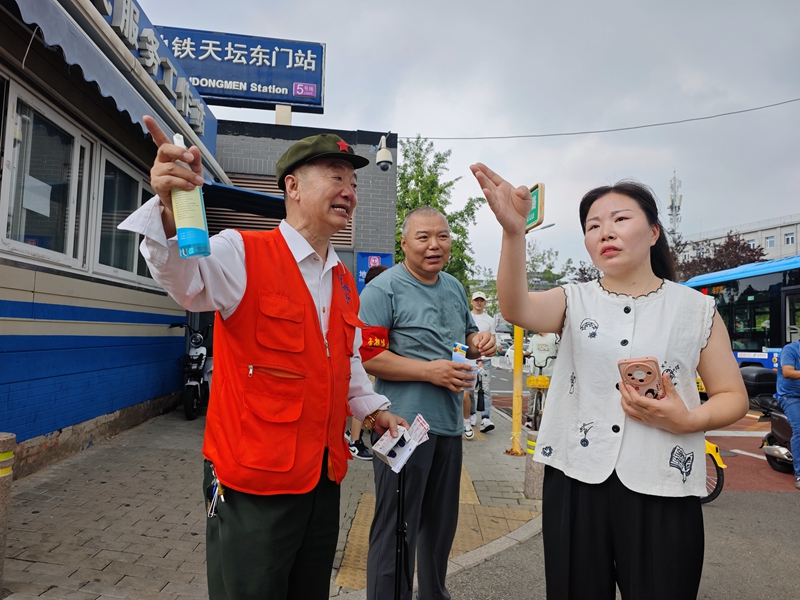During the summer vacation, the number of visitors to the Temple of Heaven Park has significantly increased. To further promote the spirit of Lei Feng, convey love and mutual assistance, and provide convenience for citizens and tourists, the Tiyuguan Road Subdistrict in Dongcheng District has set up a Lei Feng Volunteer Service Station at the east gate of the Temple of Heaven. The station is equipped with shared umbrellas, raincoats, first-aid kits, and other supplies.
On the afternoon of August 4, Liu Xuejun, known as the “Good Samaritan of Beijing,” visited Tiyuguan Road Subdistrict and joined the Lei Feng volunteers in a service initiative at the east gate of the Temple of Heaven.
The volunteer station has 30 shared umbrellas and 500 disposable raincoats, which are replenished promptly after use. In case of sudden rain, they provide timely assistance to visitors who forget their rain gear, ensuring they stay dry and safeguarding their health during their travels.
At 2 p.m., the clear sky suddenly turned rainy. “Hello, Beijing has just issued a red alert for heavy rain later today. Please finish your visit early if possible. You don’t have an umbrella, do you? Here’s a raincoat for you,” Liu Xuejun kindly reminded a visitor preparing to walk out in the rain, handing them a raincoat. Under Liu’s guidance, volunteers from the Temple of Heaven East Gate Comprehensive Management Team distributed raincoats to visitors without rain gear.
To protect visitors’ health, the volunteer station also provides shared medical supplies, including Huoxiang Zhengqi water (a traditional Chinese remedy for heatstroke), cooling patches, mosquito repellent, and band-aids.
“Excuse me, how do I get to the Natural History Museum?” “Hello, which way is the south gate of the Temple of Heaven?” “Is there a place nearby to store bags?” Many visitors approached Liu Xuejun with questions, and he patiently answered each one.
A representative from Tiyuguan Road Subdistrict stated that they will continue to strengthen the volunteer station’s services, further promote the spirit of Lei Feng, and apply effective working methods to prioritize public needs. Through various initiatives, they aim to promote civilized travel and maintain a welcoming environment around the Temple of Heaven’s east gate, enhancing visitors’ summer experiences.
Temple of Heaven Park
The Temple of Heaven Park in Beijing, China, is a historic imperial complex built in the early 15th century during the Ming Dynasty. It served as a sacred site where emperors performed rituals to pray for good harvests. Today, it is a UNESCO World Heritage Site, renowned for its stunning architecture, expansive gardens, and cultural significance.
Tiyuguan Road Subdistrict
Tiyuguan Road Subdistrict (体育馆路街道) is a residential and administrative area located in Beijing, China, known for its proximity to major sports facilities, including the Beijing Indoor Stadium. Historically, the area developed as part of the city’s urban expansion in the mid-20th century, with a focus on sports and recreation. Today, it serves as a vibrant community hub with a mix of residential, commercial, and cultural spaces.
Lei Feng Volunteer Service Station
The Lei Feng Volunteer Service Station is a cultural site in China dedicated to promoting the spirit of Lei Feng, a symbolic figure of selflessness and volunteerism in Chinese communist culture. Established to honor his legacy, these stations encourage community service and public welfare activities, often organizing free assistance programs like repairs, counseling, and healthcare. Inspired by Lei Feng’s diary and Mao Zedong’s call to “Learn from Comrade Lei Feng” in 1963, the stations embody socialist values and continue to operate across China today.
Natural History Museum
The **Natural History Museum**, located in London, is one of the world’s most renowned museums dedicated to the natural world. Established in 1881, it houses over 80 million specimens, including fossils, minerals, and iconic exhibits like the dinosaur skeletons and the blue whale model. The museum serves as both a research institution and a public attraction, showcasing Earth’s history and biodiversity.
Dongcheng District
Dongcheng District is a central urban area in Beijing, China, known for its rich historical and cultural significance. It houses many iconic landmarks, including the Forbidden City, Tiananmen Square, and the Temple of Heaven, reflecting Beijing’s imperial past and political importance. As one of the oldest districts in the city, Dongcheng has been a cultural and administrative hub for centuries, blending ancient heritage with modern urban life.
Temple of Heaven East Gate Comprehensive Management Team
The Temple of Heaven East Gate Comprehensive Management Team oversees the preservation and operations of the East Gate area of Beijing’s Temple of Heaven, a UNESCO World Heritage Site. The Temple of Heaven, built in the 15th century during the Ming Dynasty, was where emperors performed rituals to pray for good harvests. The management team ensures visitor access, maintenance, and cultural protection of this historic site.
east gate of the Temple of Heaven
The East Gate of the Temple of Heaven in Beijing was one of the main entrances to this imperial complex, where Ming and Qing emperors performed sacred rituals to ensure good harvests. Constructed in 1420 during the Ming Dynasty, the Temple of Heaven is a UNESCO World Heritage Site, renowned for its symbolic architecture and historical significance in Chinese cosmology. The East Gate, like the rest of the complex, reflects traditional Chinese design and the ancient belief in the harmony between heaven and earth.
south gate of the Temple of Heaven
The South Gate of the Temple of Heaven, known as the **Zhaogong Gate** (昭亨门), is one of the four main entrances to the Temple of Heaven complex in Beijing, a UNESCO World Heritage Site. Built during the Ming Dynasty (1420), it was part of the imperial sacrificial rituals, where emperors prayed for good harvests. The gate, aligned with the complex’s sacred axis, reflects traditional Chinese cosmology and architectural harmony.



